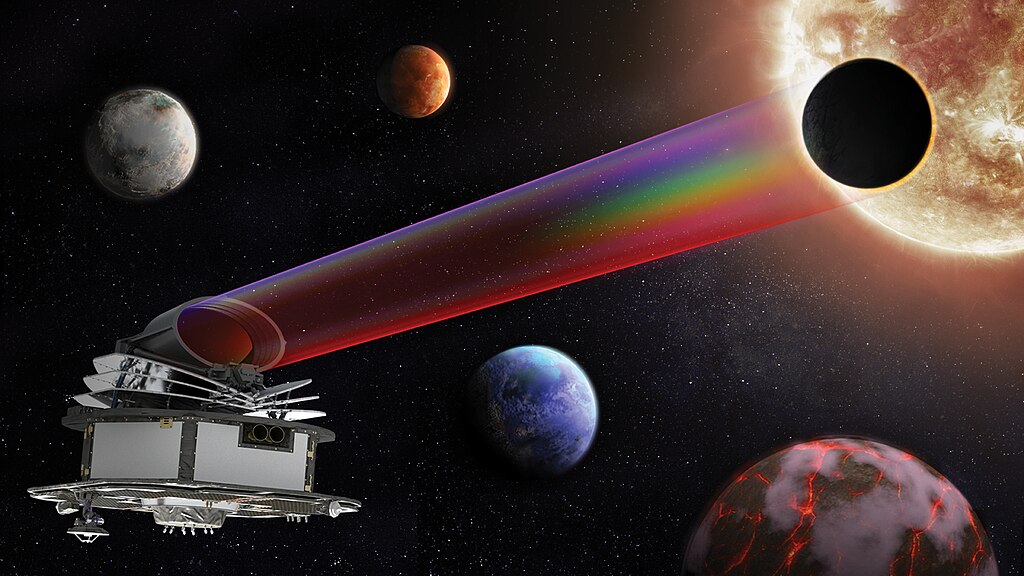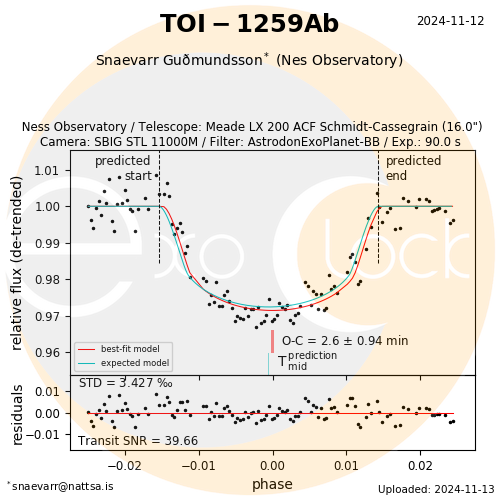Árið 2029 ætlar Geimferðastofnun Evrópu (ESA) að skjóta gervitunglinu ARIEL á loft og staðsetja í Lagrangian 2 (L2) í um 1,5 milljón km fjarlægð. L2 er einn af jafnvægispunktum þyngdaraflsins í grennd jarðar og tilvalinn staður fyrir geimsjónauka eins og Ariel. Þar verður honum beint að um 1000 fjarreikistjörnum, sem eru staðsettar víðsvegar á himinhvelfingunni, og yfir a.m.k. fjögurra ára skeið afla mæligagna um þær. Markmiðið: að leita svara úr hverju reikistjörnurnar eru, hvernig þær mynduðust og hafa þróast. Ariel er ætlað grannskoða fjarreikistjörnur á meðan þær eru í þvergöngu og efnagreina lofthjúp þeirra .
In 2029, the European Space Agency (ESA) will launch the ARIEL satellite and place it at the Lagrangian 2 (L2) about 1.5 million km away from Earth. L2 is one of the gravitational equilibrium points and an ideal location for a space telescope like Ariel. There, it will be pointed at about1000 exoplanets, located across the sky, and over a period of at least four years, it will collect data on them. The goal: to seek answers about what the planets are made of, how they formed and have evolved. Ariel is designed to monitor transiting exoplanets and analyze their atmospheres.
Mælingarnar sem ARIEL á að gera eru óframkvæmanlegar með jarðbundnum sjónaukum. En til þess að viðhalda afkastagetu gervitunglsins er nauðsynlegt að þekkja viðmiðstíma, umferðartíma fjarrreikistjarnanna og hvenær þvergöngurnar eiga sér stað. Þessir þættir eru stundum misvel skorðaðir og í ákveðnum tilfellum er óregla í brautartímum. Til að undirbúa ARIEL réðst ESA í það verkefni að nýta mælingar sem eru gerðar litlum sjónaukum af jörðu niðri til þess að ákvarða og skorða lotubundnar þvergöngur áður en því verður skotið á loft.
The measurements planned for ARIEL are impossible with ground-based telescopes. However, in order to maintain the satellite’s performance, it is vital to know the ephemerides, the period of the exoplanets and transit timings. These factors are sometimes not well constrained, and in some cases there is an irregularity in the orbital times. To prepare for ARIEL, ESA undertook the task of using measurements made by small ground-based telescopes to determine and constrain periodic transits before the launch.

Mynd/Fig. 1. Mynd listamanns af Ariel gervitunglinu og verkefni þess. – An artist’s impression of ESA’s mission Ariel (Atmospheric Remote-sensing Infrared Exoplanet Large-survey). Heimild/Credit: ESA, CC BY-SA IGO 3.0. Image accessed on Wikipedia.
Um þetta snýst “Exoclock verkefnið“; þar sameina krafta stjörnufræðingar, stjarnmælingamenn, námsmenn og aðrir með ástríðu á rannsóknum á fjarreikistjörnum. Verkefnahópurinn nefnir sig “ARIEL Ephemerides Working Group” og vinnur að undirbúningi gervitunglsins og hefur m.a. sett upp vefsvæði með gagnagrunni fyrir mælingar. Þeir hafa þróað nauðsynleg veftól og hugbúnað (HOPS) sem er aðgengilegur á vefsíðunni og má nota í frumvinnslu mælingagagna og úrvinnslu til þess að ákvarða miðju þvergöngu, myrkvadýpt og aðrar eigindir. Mælingagögn hafa verið aflað héðan og þaðan af jörðinni, við mismunandi kringumstæður og með mismunandi sjónaukategundum, myndavélum og litsíum.
This is what the “Exoclock Project” is about; it brings together astronomers, amateurs, students and others with a passion for exoplanet research. The project group calls itself the “ARIEL Ephemerides Working Group” and is working on the preparation of the satellite and has, among other things, established a website with a database. They have developed the necessary web tools and software (HOPS) that are accessible on the website and can be used in the initial processing of measurement data and processing to determine the mid-transit, transit depth and other properties. Measurement data are acquired from all over the Earth, under different circumstances and with different types of telescopes and cameras with different colour filters.
Ljósmælingar - Photometry
Höfundur vefsetursins hefur tekið þátt í gagnaöfluninni á þvergöngum fjarreikistjarna og sent inn mælingar síðan 2023 í gagnagrunn Exoclock. Reiknitólið sem notað er í úrvinnslu er mjög þróað og metur gæði mæligagna. Þegar mæligögn uppfylla ekki tiltekin ákvæði sem er krafist verða þau ekki gagni. Fyrir vikið reynist veftólið góður prófsteinn á gæði mælinga.
The author of this website has provided data of exoplanet transits and submitted it to the Exoclock database since 2023. The web tool used for the analysis is sophisticated and evaluates the quality of the data. If the measurements do not meet the applied criteria, they will not be useful. As a result, the web tool provides a good indication of the quality of the measurements.

Mynd/Fig. 2. Niðurstöður úr athugun á þvergöngu fjarreikistjörnunnar TOI-1259A b frá 12. nóvember 2024. Mynd fengin úr gagnagrunni Exoclock. – The result from an observation of the exoplanet transit of TOI 1259A b, on November 12, 2024. The plot accessed in the Exoclock database.